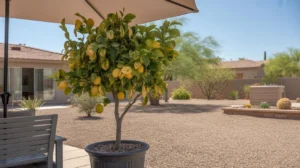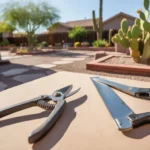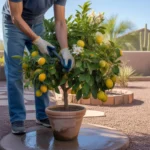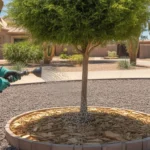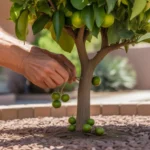Queen Creek’s intense summer heat can be punishing for potted citrus trees. Without the right care, even sun-loving varieties like lemon and lime can suffer leaf scorch, branch dieback, and reduced fruiting. But with a few smart adjustments, you can help your container citrus not just survive but thrive through the worst of the heatwaves. Here’s how to give your potted citrus trees the TLC they need to handle Queen Creek’s summer sizzle.
Provide Afternoon Shade
While citrus trees love full sun, the harsh afternoon rays in Queen Creek can be too much for container-grown trees during peak summer. Their limited soil volume makes it harder for roots to stay cool and moist. To prevent heat stress and sunburn, give your potted citrus a break from direct sun exposure during the hottest part of the day.
Move the containers to a spot that gets bright morning light but is shaded from intense western sun, like the east side of your home or near a shading tree. You can also erect a temporary shade sail or use a large patio umbrella to cast protective shade over the citrus pots during the afternoon. The goal is to provide relief during the most intense heat without completely depriving the sun-loving citrus of bright light.
If you can’t relocate the heavy pots, try wrapping the containers themselves in a reflective material like aluminum foil to deflect some of the punishing rays and keep the roots cooler. Avoid dark-colored pots that absorb more heat.
Water Deeply and Frequently
Citrus trees have a high water demand, and the need increases even more during Queen Creek’s summer scorchers. The limited soil in containers dries out much faster than in-ground plantings, so it’s crucial to water potted citrus more often to keep the roots hydrated and cool.
During a heatwave, your potted citrus may need watering daily, especially if they’re in terra cotta pots that wick moisture quickly. Water deeply until you see it running out the container’s drainage holes. This ensures the entire root ball gets thoroughly soaked. Avoid frequent shallow watering, which encourages weak surface roots that are more vulnerable to heat and drought.
To reduce evaporation, water in the early morning when it’s cooler. Adding a layer of organic mulch like bark chips or straw on top of the soil helps retain moisture longer. You can also place a large saucer under the pot to catch excess water that the tree can draw from as the soil dries out.
Boost Humidity Around Foliage
Low humidity and hot, dry air during a heatwave can cause citrus leaves to curl and brown at the edges. While you can’t control Queen Creek’s arid climate, you can raise the humidity level directly around your potted citrus to minimize moisture loss through the foliage.
Mist the leaves with water in the morning and evening to provide a refreshing humidity boost and help cool the foliage. Avoid misting in the afternoon, as water droplets can scorch leaves in direct sunlight. You can also use a pebble tray by filling a shallow tray with pebbles and water and placing the citrus pot on top. As the water evaporates, it raises humidity around the tree.
Grouping potted plants closer together also creates a more humid microclimate as the plants transpire moisture. Consider moving your citrus pots near other lush, well-watered potted plants during a heatwave to trap humidity between the foliage.
Avoid Fertilizing During Extreme Heat
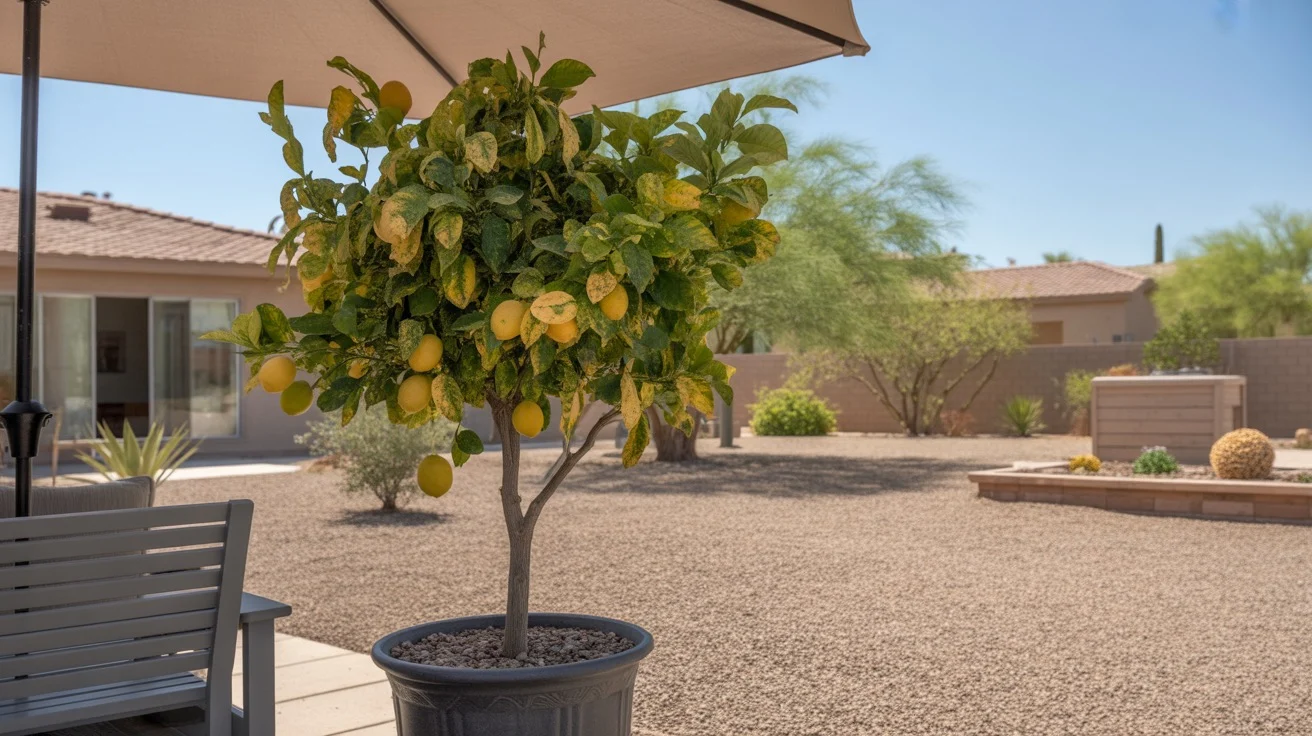
While citrus trees are heavy feeders that benefit from regular fertilizing during the growing season, it’s best to avoid feeding during periods of extreme heat stress. Applying fertilizer can stimulate tender new growth that’s more vulnerable to sunburn and heat damage.
If you’ve been feeding your potted citrus on a monthly schedule, it’s okay to skip a feeding during a severe heatwave and resume after the intense heat breaks. The tree will direct its energy toward survival rather than new growth. You can help reduce stress by removing any flowers or developing fruit so the tree can focus on maintaining healthy leaves and roots.
Once the heatwave passes and temperatures drop back to normal for Queen Creek, you can restart your regular citrus fertilizing routine, preferably with a slow-release, organic citrus fertilizer that provides a steady supply of nutrients without overwhelming the roots.
Watch for Sunburn and Heat Stress
Despite your best efforts to shield your potted citrus from Queen Creek’s brutal heat, some sunburn and heat stress may still occur. It’s important to catch it early so you can move the tree to a more protected spot and nurse it back to health.
Sunburned leaves develop pale yellow or white patches that eventually turn brown and crispy. The damage usually appears on the south or west side of the tree that gets the most direct afternoon sun exposure. Leaves may also curl inward or drop prematurely. Sunburned bark splits vertically and oozes sap.
If you spot sunburn on your potted citrus, provide more shade immediately and boost the watering frequency to help the tree recover. You may need to prune out badly damaged leaves and branches to encourage healthy new growth after the heatwave subsides. Applying a reflective tree paint to the trunk can prevent further bark splitting.
Pamper Potted Citrus Before and After Heatwaves
Healthy, well-maintained citrus trees are better able to withstand Queen Creek’s intense summer heat than stressed, neglected trees. Implementing good care practices before a heatwave arrives prepares your potted citrus to handle the extreme conditions without suffering major damage.
In spring and early summer, keep citrus well-watered and fertilized to support lush foliage growth that can shade and protect inner branches. Apply a layer of organic mulch to insulate roots and retain soil moisture. Consider moving pots to a spot that gets afternoon shade before peak summer heat arrives.
After a heatwave passes, give your potted citrus a little extra TLC to help them recover. Remove any dead, sunburned leaves or branches to direct energy to healthy growth. Feed with a diluted fish emulsion or kelp solution to provide a gentle nutrient boost. Keep soil consistently moist but not soggy to avoid stressing the roots.
With proper care and attention, your potted citrus trees can bounce back from Queen Creek’s brutal heatwaves and continue providing you with fragrant blossoms and delicious fruit for years to come. By shielding them from harsh rays, keeping them well-hydrated, and avoiding heat stress, you’ll help these sun-lovers thrive even in the toughest conditions.

